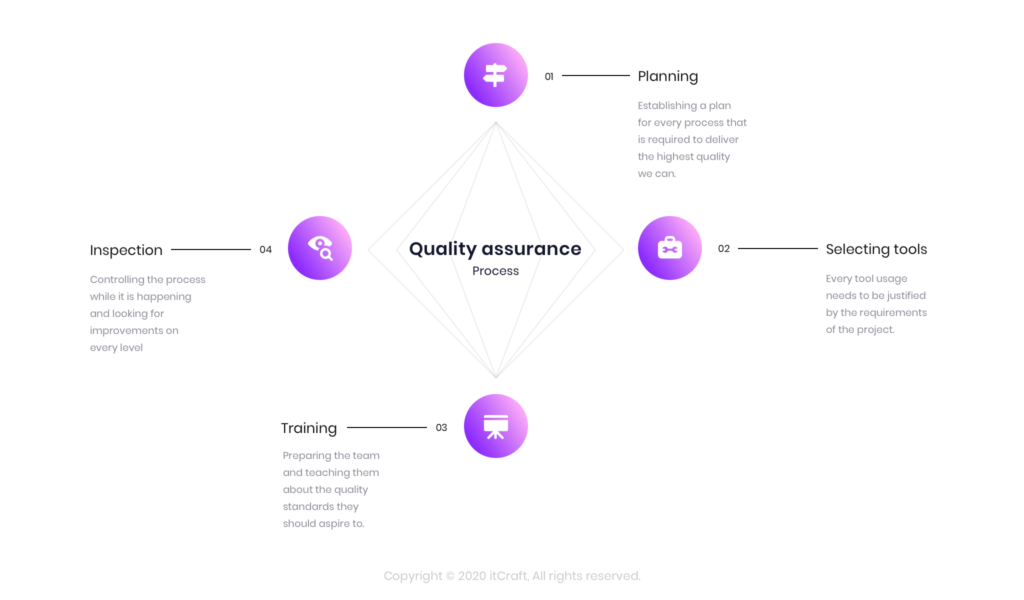What is the role of quality assurance in software development?

Łukasz Górski

Alexa Trachim

Every big idea needs to be tested before being released to the public. Why? Because we want to give our customers a product that works properly, looks elegant and doesn’t have any issues whatsoever. Without testing, that wouldn’t be possible – first of all, because developers are only people. They can make mistakes and overlook them, so adding another instance that will be focused on finding bugs instead of writing code is always a good idea. Also, sometimes, one solution won’t work for business requirements, so testers always check the practical side of the product and make sure it meets the project’s specifications.
Table of contents
- What is the role of quality assurance?
– Quality management system - The process of quality assurance
- What is the difference between QA and QC?
- Examples of quality assurance
- Quality assurance in software development
– Functional vs. Non-functional testing
– Manual vs. Automated
– Examples of testing areas - Quality assurance – do I really need it?
This article is about a significant area of software development and a crucial part of building web and mobile apps – quality assurance (QA).
What is the role of quality assurance?
Quality assurance (QA for short) is the area of production responsible for detecting issues and preventing failures. The goal is to provide the highest quality to the customers and to create a product or service that is compatible with requirements and expectations.
This division is not only present in software houses – it is a part of many other industries, as every company wants to deliver ideal solutions to their customers. Having the manufacturers scan the results of their work to find out if there are any problems with it would take a lot of time and burden them with additional duties. That’s why there are quality assurance specialists hire – and their primary purpose is to test the concrete object in many different ways.
Quality management system
Quality assurance needs to meet some standards to be considered valid. That’s why every company needs a quality management system, a set of principles that they follow to provide the highest quality of their goods and to enhance customer satisfaction continuously. ISO 9000 standards mostly regulate these rules.
The quality management system is a broad definition that includes mission and vision, goals and aspirations, legal regulations, policies, all the processes and resources, quality control activities and documentation. Every company should have its own system to ensure quality is always on the same level. Using ISO 9000 can be helpful to mark out the guidelines and ethical practices.

The process of quality assurance
What are the elements of quality assurance? Here are essential points to take care of:
- Planning – establishing a plan for every process that is required to deliver the highest quality we can.
- Selecting tools – every tool usage needs to be justified by the requirements of the project.
- Training – preparing the team and teaching them about the quality standards they should aspire to.
- Inspection – controlling the process while it is happening and looking for improvements on every level.
And, of course, testing the product or service itself, which we will discuss below.
What is the difference between QA and QC?
QA and QC – which stands for quality assurance and quality control – are often used interchangeably. Although they complement each other and have their common goal, these are two methods that have a slightly different purpose.
The main focus of quality assurance is prevention. It helps to verify the manufacturing processes to see if they are happening in accordance with previously defined demands. It occurs before quality control – it should detect the majority of the defects before the product is finished and ready for being tested as a whole.
Quality control is a set of techniques that testers use to find the defect in the outcome. Developed products are tested in many ways to ensure that all the aspects of product quality are met and include every standard that was determined at the beginning of the project.
There is also a type of QC called statistical quality control or statistical process control. Usually used in manufactures for production lines, it uses particular measures to constantly check if the process is working as designed without any abnormalities.
Quality control, quality assurance – they are both necessary to provide a product or service that meets the best quality that we can achieve.

Examples of quality assurance
You know now what is quality assurance. We can describe it furtherly using concrete examples. There are several ways to fulfill quality assurance, quality control and testing necessities, for example:
Documentation
Preparing thorough documentation that describes every process is a must for every project. This way, the whole team knows what the dos and don’ts are and how to perform each step. It should contain all the information that anyone would need while working on the product.
Audits
They are usually performed at the end of the process to find out what was done well and what could be better. It may be used to find the weak points of the whole process and learn how to improve them in the future.
Code inspection
Tests applied to the code by a third party (tester, not code author) to find bugs and eliminate them before they escalate in the project. There are many types of tests used in code inspection and we will examine the most popular ones further in this article.
Design inspection
Tests related to design are rather complex. They control how the interface works – if the logic is correct, how to fix issues within the product, if the functionalities work as expected and more. They also look up performance rates to see if it works fast enough, or is there something slowing it down.
Quality assurance in software development
We’ve discussed some general concepts regarding quality assurance, but let’s focus on software development. Software quality assurance is QA in programming and software testing is the equivalent of quality control. Let’s jump right into types of testing that are used in software quality assurance. This way, you will be able to understand them better.
Functional vs. Non-functional testing
In the most basic definition, functional testing determines what the product does, while non-functional testing determines how it does it.
Functional tests are based on business assumptions – so their main goal is to check it all the features work correctly and deliver results that might be expected by the users. Non-functional tests, on the other hand, verifies the performance of the software and tries to look for improvements in that matter.
Functional tests are usually performed manually, but non-functional ones are automated.
Manual vs. Automated
You can probably guess what’s the difference between those two. Manual tests are performed by humans – quality assurance experts hired to do just that. But that’s not their only duty. Some of them write software tools used for different types of testing that require more computing power or atypical conditions.
While manual tests are often claimed to be less reliable as they introduce the human factor, that is not necessarily a bad thing. Software engineering can be a process that frequently forgets that people have various ways of acting, so it should be more human-like. With manual tests, the final product or service will be the subject in different scenarios that will check if using it is intuitive, logical and straightforward.
If we need fast, repetitive tests without human insight – automated are the way to go. They take less time when performed, but require more extended periods to be prepared. Unlike manual tests, they can run 24/7 and produce results that wouldn’t be achievable only with people on board.
Examples of testing areas
Software quality assurance is used to test each process. In organizations like software houses, we hire whole quality assurance departments to have a range of specialists in different types of testing. Here are a couple of tests we run with our web and mobile apps:
Unit tests
The smallest part of the coded program is the unit. In this type of testing, every module is reviewed separately. Tests are performed to find out if all the functionalities work as they supposed to.
Integration tests
After unit testing, modules are combined into bigger groups and elements to see how they cooperate. The reason is to do that is to see how data flows between units.
System tests
After integrating all the components, the whole system is tested. At this stage, we need to see how the product works in terms of performance and security. Functional and non-functional tests are involved to give the product a whole rundown.
Other tests
There are dozens of testing types, each dedicated to other areas of the software development process. There are stress tests that determine if the app or website can handle colossal traffic – automated systems create fake requests in significant amounts to see if the software won’t crush. Acceptance tests are dedicated to analyzing the contract with the clients and finding out if all the requirements are included in the outcome. Usability testing is a crucial part that examines the user-friendliness and convenience of the system to support efficiency.
Of course, we always pick the testing methodologies that are suitable for a concrete project. Each business organization has different needs and pains, so we still apply an individual approach.
Quality assurance – do I really need it?
Each process in software development is crucial for the future success of your web or mobile app – so the answer is yes! Don’t cut your budget and invest in quality assurance. We have confidence in the worthiness of it.
And if you would like to work with a software house that has experience with many international clients and offers an experienced team of quality control and assurance experts – please contact us. The quality of your product is one of our highest priorities. Let’s work together to produce extraordinary results when it comes to software development!
Read more
We explain what is the dedicated team pricing model
Google Glide – Create mobile app in spreadsheets without coding
Ebooks for junior iOS and Android developers






